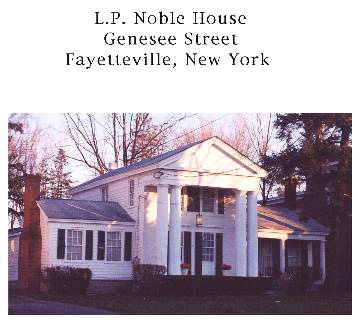
Linneaus P. and Harriet Noble House
Genesee Street
Fayetteville, New York
c. 1850-55
Linneaus P. Noble was an active abolitionist from Fayetteville, New York, from at least the early 1840s until the Civil War. He gave a speech at the Liberty State Convention in Peterboro, New York, in January 1841. From January 1847 to 1860, he published the Washington-based National Era, the anti-slavery newspaper in which Harriet Beecher Stowe’s Uncle Tom’s Cabin first appeared.
Biography
Born November 1, 1802, in Hoosick, New York, L.P. Noble married Harriet Edwards in 1828 and moved to Fayetteville in 1829. An abolitionist leader, he was identified with a central New York circle that included Gerrit Smith, James C. Jackson, and Luther Myrick.
As founder and publisher of the National Era from 1847 to 1860, he worked with its editor Gamaliel Bailey, as well as with such correspondents as Henry B. Stanton. The National Era published Harriet Beecher Stowe’s Uncle Tom’s Cabin in 40 serial installments in 1852. When Stowe’s work appeared in book form, it sold more than one million copies in nine months.
Noble was a Sabbath school superintendent and deacon of the Fayetteville Baptist Church, one of the directors of the Syracuse National Bank, and President of the Fayetteville and Syracuse Plank Road. “Every reform of a civil, moral, or social character found in him a cordial supporter,” noted one obituary. (The Examiner and Chronicle, March 6, 1873)
He died on January 26, 1873, aged 70 or 71, and is buried in the Fayetteville Cemetery. His obituary noted that
He was a man of commanding presence, large brain, considerable intellectual culture, a good speaker, and an honest man. He might have filled high political stations, but his radical views kept him in the minority. His generous spirit could not be fettered by sectarian narrowness, or the blind bigotry of a corrupt public sentiment. He cared not for office—he wanted honesty and honor in the conduct of public affiars. (The Examiner and Chronicle, March 6, 1873)
Another obituary noted that “he was always found prominent in reform undertakings, and was bound to no political party.” (Journal, January 27, 1873).
(Biographical information from Barbara Rivette and obituaries, as noted.)
Site
The house stands in its original location on East Genesee Street, in the Limestone-Genesee Street Historic District. It may incorporate an earlier building, since one obituary noted that Noble had, “with the exception of a few years, resided where he died.” (Examiner and Chronicle, March 6, 1873). As it currently stands, the house is a double-wing Greek Revival with a front pediment held up by fluted Doric columns, two on either side of the two windows in the center of each floor of the façade. Flush boards cover the façade. Clapboards cover the side and wings. The east wing has Roman Doric columns. The west wing is enclosed. The house was robably built in several stages, beginning about 1829. The main façade probably dates to 1852-56.
Sources
Journal, January 27, 1873
Madison & Onondaga Abolitionist, February 22, 1841.
Rivette, Barbara S. “L.P. Noble,” biographical sketch, April 16, 2002.
Special thanks to Barbara Rivette for her help.
Further Research
Further research, particularly in local newspapers and in abolitionist newspapers such as the Friend of Man, Liberty Party Press, Madison & Onondaga Abolitionist, and National Era would undoubtedly give more details about Noble’s abolitionist activism. Census reports would define who lived in the house at various periods. Church records would give a context for their reform work.
Research in deeds, mortgages, assessments, and maps would help determine a chronology for the building.
